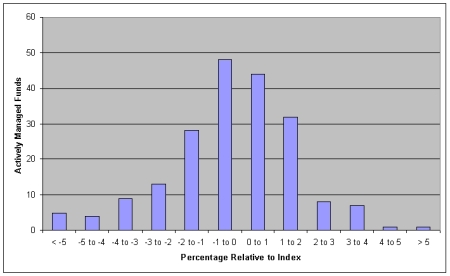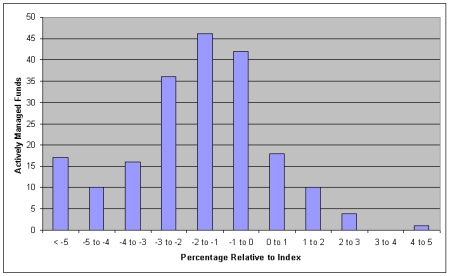In a previous post I wrote about John Bogle’s 8 rules for selecting actively managed mutual funds. That post detailed the best ways to reduce costs and maximize returns when selecting actively managed mutual funds. The best way to minimize costs and risk, while maximizing returns is to invest in index funds rather than actively managed mutual funds. John Bogle beats this into your head over and over again in his book. I’m also a subscriber to the belief that index investing is the best way to invest your retirement nest egg when comparing index funds to actively managed mutual funds. Operating Expenses A simple comparison of an index fund (Wilshire 5000 Equity Index) and actively managed mutual funds that have similar weightings to the index fund, will show the effects of operating expenses and the inferiority of active managers. Managers that actively track the market should beat the market 50% of the time and lose to the market 50% of the time. The following chart compares the number of funds with the performance (gross return) relative to the index fund over a 15 year period ending in 1998. As you can see from the bar graph, roughly 50% of all actively managed mutual funds out performed the index fund when comparing gross returns. The graph above is very similar to the standard bell curve. The only problem is that investors do not receive the gross returns. Investors only get to take home net returns, which are diminished by operating expenses. The following chart compares the number of funds with the performance (net returns) relative to the index fund over the same 15 year period ending in 1998. As you can see from this bar graph after removing operating expenses, only 16.5% of actively managed funds provided returns greater than the index fund. Clearly the benefits of having an active manager, like timing the market, do not compensate for the added operating expenses of investing in an actively managed mutual fund. Sales Charges The above data does not even take into account sales charges. Any actively managed mutual fund that charges front end or back end sales charges also diminishes your return on investment. 12b-1 fees are another way for active managers to dip into your retirement nest egg. Survivorship Bias Survivorship bias (and as much as it sounds like a good ole George W. Bush created term like strategery) in this instance is the tendency for past mutual fund data to not include failed mutual funds. The data used in constructing the two graphs only represents the mutual funds that were liquidated or merged into another fund. Most of the time funds are liquidated or merged it is because of poor returns and the fund complex doesn’t want to keep funds with poor returns in the market. Survivorship bias most likely decreases the number of actively managed mutual funds whose returns fell short of the index fund. Turnover Rate Turnover rate is only an issue if you are evaluating funds held in non-tax sheltered accounts. The turnover rate for index funds is very low as turnover is only created if companies drop out of the index being tracked. The turnover rate for actively managed mutual funds is much higher as managers try to time the market or remove losers to make the fund more marketable. Turnover rates for actively managed mutual funds can average as high as 80%. Turnover rates are important in non-tax sheltered accounts as higher turnover rates lead to more capital gains taxes. Conclusion I’m a huge fan of index investing and believe most of your retirement nest egg, if not all of it, should be in index funds. This is especially the case when comparing index funds to comparable actively managed mutual funds. The operating expenses, sales charges, survivorship bias and turnover rate all tip the scales in favor of the index fund. One major drawback towards index investing is that you can never beat the market. If you’re ok with tying the market, but beating the average investor, including most of your friends and family with minimal effort then index investing is for you. * All of the data from this post came from John C. Bogle’s book “Common Sense on Mutual Funds”, which I highly recommend reading. |
Index Investing Is A No Brainer
Posted in Investing, Retirement.
– August 27, 2008










